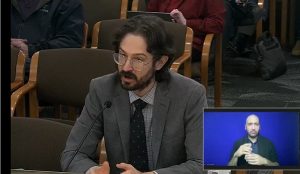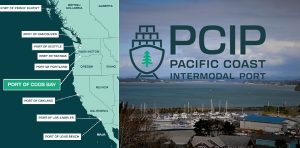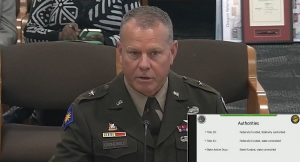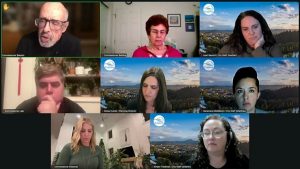FEMA actions threaten funds for emergency managers
10 min read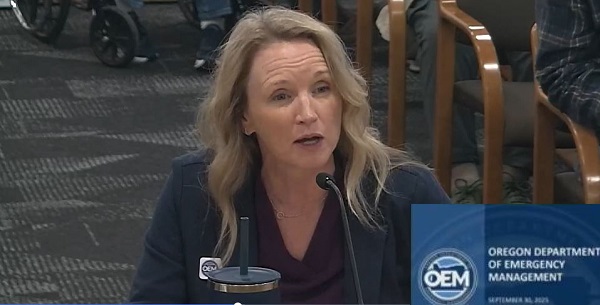
Presenter: Oregon’s Department of Emergency Management discusses its response to abrupt changes to federal funding. Sept. 30 at the Senate Interim Committee On Veterans, Emergency Management, Federal and World Affairs, Director Erin McMahon:
Erin McMahon (Department of Emergency Management, director): You’re no doubt aware that the Department of Homeland Security, including FEMA, has had some changes. It’s been a lot of stop-and-go, it’s created a lot of tension across the state as we try to work and prepare for our next disasters.
[00:00:33] But I wanted to assure you that your team of professionals at OEM and your local emergency managers across the state have continued to dig in to do the important work of emergency management despite a lot of the uncertainty that we’ve experienced.
[00:00:51] And I personally have had the opportunity to elevate the significant distinctions of providing emergency management in our rural communities in the Pacific Northwest, where we deal with threats of all nature, whether that be wildfire, tsunami, earthquakes, you name it, we’ve seen it, and I feel like I’ve seen all of it since I’ve been here, which is only two years and running.
[00:01:22] But just a reminder, emergency management covers the preparedness, mitigation, response, and recovery from disaster, and our program does all of those.
[00:01:33] Some of our open disasters that we have had in Oregon over the past 10 years, over $2.4 billion has been allocated, payments have been made in response to public assistance requests following disasters, a good portion from the federal government.
[00:01:54] And with some of the changes that we have seen here in Oregon, those dollar amounts are shifting. The proposed thresholds are shifting for when FEMA is going to continue to provide that assistance. We’re keeping our eye on that and we are tracking that.
[00:02:10] Despite this fact, we were successful in receiving a major disaster declaration for the 2025 flooding event that occurred in Douglas / Coos / Curry County and recently adding Josephine to that list.
[00:02:24] We were unable to get a disaster declaration for Harney County, that flooding, and we were not able to get, we did not meet the thresholds for a disaster declaration for that devastating Rowena Fire that occurred out in Wasco County earlier this summer.
[00:02:40] The challenges there, of course, are that Oregon does not have a individual assistance or public assistance program. And as we see these thresholds rising and the opportunity for those federal dollars diminishing, the role of the state is going to become more and more important because those communities, they just don’t have the programs to help in that recovery.
[00:03:03] We’re working very hard with Wasco County through the governor’s office to look for ways that we can help that community to recover from that disaster. But those programs, while we have funds established in law, they are not funded.
[00:03:20] One of the things that we have done in light of these shortfalls that we’re seeing from FEMA’s side is we are really putting additional pressure on our other federal agencies trying to do what I promised the governor we would do, and that is to eke out every federal dollar that we can locate.
[00:03:39] The Small Business Administration is one way that we can do that, and we have made new ground in achieving declarations with them to provide low-cost loans to families, renters, and businesses. We also work very closely with the U.S. Army Corps of Engineers in response to that flooding that occurred out in Harney County. And we’ve also been working directly with USDA to try to bring in those additional dollars. When USDA is federally funded, they are very willing to assist and help us.
[00:04:11] We have seen one of the programs I know you have heard about from your constituents and your communities is the changes that have occurred with the BRIC program, that Building Resilient Infrastructure and Community program: It has been canceled going forward.
[00:04:26] It leaves into question the almost $18 million in projects that we were planning. And communities have been planning to develop, you know, vertical tsunami towers that were already in phase one construction are now waiting for approval for additional federal dollars.
[00:04:50] These communities that did the hard work of identifying, doing the community interaction, of getting the support for these projects, the millions of dollars some of these communities have spent in plans, filings are now in question because we have not received those federal dollars.
[00:05:11] HMGP (Hazard Mitigation Grant Program): That is a program that allows us to do hazard mitigation work following a disaster. Traditionally, any time we would get a public assistance declaration, we would also get those hazard mitigation dollars.
That was not the case this year in Douglas, Coos and Curry. And that means that we don’t have a program that’s going to be able to purchase out homes that are in areas that are not sustainable. It’s not going to allow us to do a lot of the clearing that we would like to do in those areas to prevent against future flooding and/or future wildfires.
[00:05:50] I will tell you personally, I was out at the Flat Fire recently that occurred out in our Sisters area. And that community was saved by the home hardening and mitigation work that that community did. And that work was funded through variety of other mitigation programs. Had that work not been done, you would have been looking at a very significant disaster.
[00:06:14] Over 800 homes were protected by our Wildfire and State Fire Marshals Office because of the home hardening and the mitigation work that has been done. So I just cannot emphasize enough how important mitigation work is and the current administration at the federal level is not supporting of that.
[00:06:35] You know mitigation is one of those tricky things, right? When you invest in it, you’re not sure if it’s going to work, but when you see the impacts, when you see how that fire moved very quickly and was able to stop with various fire breaks that they were able to establish, it is very impressive.
[00:06:52] Presenter: Director Erin McMahon discussed the emergency management performance grant.
[00:06:57] Erin McMahon (Department of Emergency Management, director): I’ve spoken to you about this grant in the past; 80% of this grant, those grant dollars go to our local emergency managers. That pays their salaries. So that’s a 50/50 cost share. And I will tell you in our rural areas where we are one emergency manager deep and they are also the sheriff and they are also driving the ambulance, the inability to provide them those funds is risky. It is very risky. It puts those areas that are most vulnerable to wildfire at risk.
[00:07:28] And those emergency managers—they’re the ones that are working to initiate those alert warnings and exercising those lifesaving evacuations and not having them in the seat is very detrimental to Oregonians. And so we’ve spoken in the past about the fact that we are so reliant on these federal dollars to provide what I believe to be essential emergency management capability across our state.
[00:07:57] One of the things that we noticed is traditionally we would get the notice of funding opportunity in the spring to apply for the next session, right? We did not get that notice of funding opportunity until August of this year. It required a very quick turnaround.
[00:08:14] Some of them are like the emergency management performance grant, that covers a wide variety of programs and training and activities that can be performed.
[00:08:24] Other grants like the Homeland Security grant, they require specific projects that then have to be vetted and approved. So the turn on this has been very tight.
[00:08:35] Additionally, you’re probably aware that there are terms and conditions that were attached to these grants, which we’ve been working with the Department of Justice and a variety of litigation to address so that we could actually receive the dollars.
[00:08:50] And one of the grants, we just received a word of last Friday, normally, the UASI (Urban Areas Security Initiative) grant would be a three-year period of time that we could use to spend those dollars, it was reduced down to one.
[00:09:04] So big changes, a lot of inconsistency, no notice is, you know, we are kind of in a wait and see as we’re trying to watch how they figure out how they’re going to execute these dollars in the future.
[00:09:18] Okay, you might be tracking that there’s been national news regarding the FEMA Review Council. As I mentioned, I’ve had the opportunity to speak at this council to provide feedback on behalf of the Pacific Northwest.
[00:09:30] Some of the things that they really talk about is the role of the state. When I have an opportunity to speak at that level, I emphasize the fact that your state emergency management, we’re not sitting around waiting for FEMA to show up with water bottles, right? We have a ‘Be 2 Weeks Ready’ campaign that’s out there. We do a lot of preparedness, we have community volunteers.
[00:09:53] Oregonians are ready and prepared to respond to disaster. We prepare ourselves. We are a very resilient bunch. However, we have been reliant on these federal dollars to help feed some of these programs and to help us in that recovery. And any changes to the federal funding, we’re going to have to figure out a way to balance that. And we need to balance that with a little bit of time so we can make those adjustments. Turning the switch off on those federal dollars is not going to be helpful to us in the long run.
[00:10:27] But, that being said, they do have an emphasis that these states are going to need to pick up the additional tab and we are going to see that in the form of adjustments to the cost share. Right now, public assistance when it is provided is 75% federal to 25% state. They’re looking at proposed adjustments to that cost share, making a larger investment at the state level.
[00:10:52] So we will see what the final decision is regarding FEMA, will FEMA exist, in what form will they exist and how will funding be provided in the future but we will continue to advocate on behalf of Oregonians as we have the opportunity to do so.
[00:11:08] All right as I’ve mentioned some of the challenges that we’ve had with that federal uncertainty, the shorter timelines that we’re seeing— right now we’ve got over $180 million in COVID reimbursement that has been sitting at the Department of Homeland Security’s office since June. And we don’t know if we’re going to get those dollars. It’s been sitting at the Director of Homeland Security’s office because they had added a new requirement that anything over $100,000 has to have her signature. So there’s a stack there, and we’re just waiting for that to be approved.
[00:11:49] Finally, I do have a dual role as the Homeland Security Advisor, and we don’t have a separate program that supports Homeland Security in our state like other states do. I have spoken to this committee in the past about our plan to build out a watch capability as we look to improve our crisis management system. Unfortunately we weren’t able to receive the investments this year but despite that fact we were able to release a new Homeland Security strategy.
[00:12:19] And we are continuing to do the best with what we got and making that coordination so that we can ensure that we are receiving the information and we are sharing information about Homeland Security threats in our state.
[00:12:32] And we are continuing right now to make those changes that we need for that Oregon Watch Center, which is set to go live next July.
[00:12:42] Presenter: Senator Khanh Pham:
[00:12:44] Sen. Khanh Pham: It sounds like in terms of emergency management funding, you’re facing a general direction from the federal government to really want to shift a lot of the costs to states for the states to shoulder more of the burden for funding. I’ll speak as the Housing chair: We’re also seeing similar orientation and direction in the housing area. So what are you anticipating the state needs to do in the future?
[00:13:06] Presenter: Director McMahon:
[00:13:08] Erin McMahon (Department of Emergency Management, director): There are a number of proposals that would address some of these gaps, right, whether it’s funding emergency management in general. The state under ORS 401 has a requirement to ensure that every county has an emergency manager, but there is no direction on who actually pays for that, right?
[00:13:26] There is some discussion about whether or not that should be fully funded to ensure that we always have an emergency manager out in all 36 counties.
[00:13:37] There’s also have been discussions about individual assistance and public assistance programs. And as I mentioned, we do have two programs on the books, a loan and grant account and mitigation account on the books that could be funded. And if funded, could be used to provide support to communities that have been impacted.
[00:14:01] I wanted to just throw out there too, just to let you know, our team is going to be doing the first-ever readiness fair, where we’re opening the doors at OEM, providing an opportunity for the community to come in and learn a little bit more about readiness. And that is going to be on Oct. 11 from 11 a.m. to 3 p.m. at OEM offices.
[00:14:22] Presenter: Oregon officials say emergency management has relied on federal funding in the past, but the state will now have to step up, especially for mitigation and for our rural areas.
